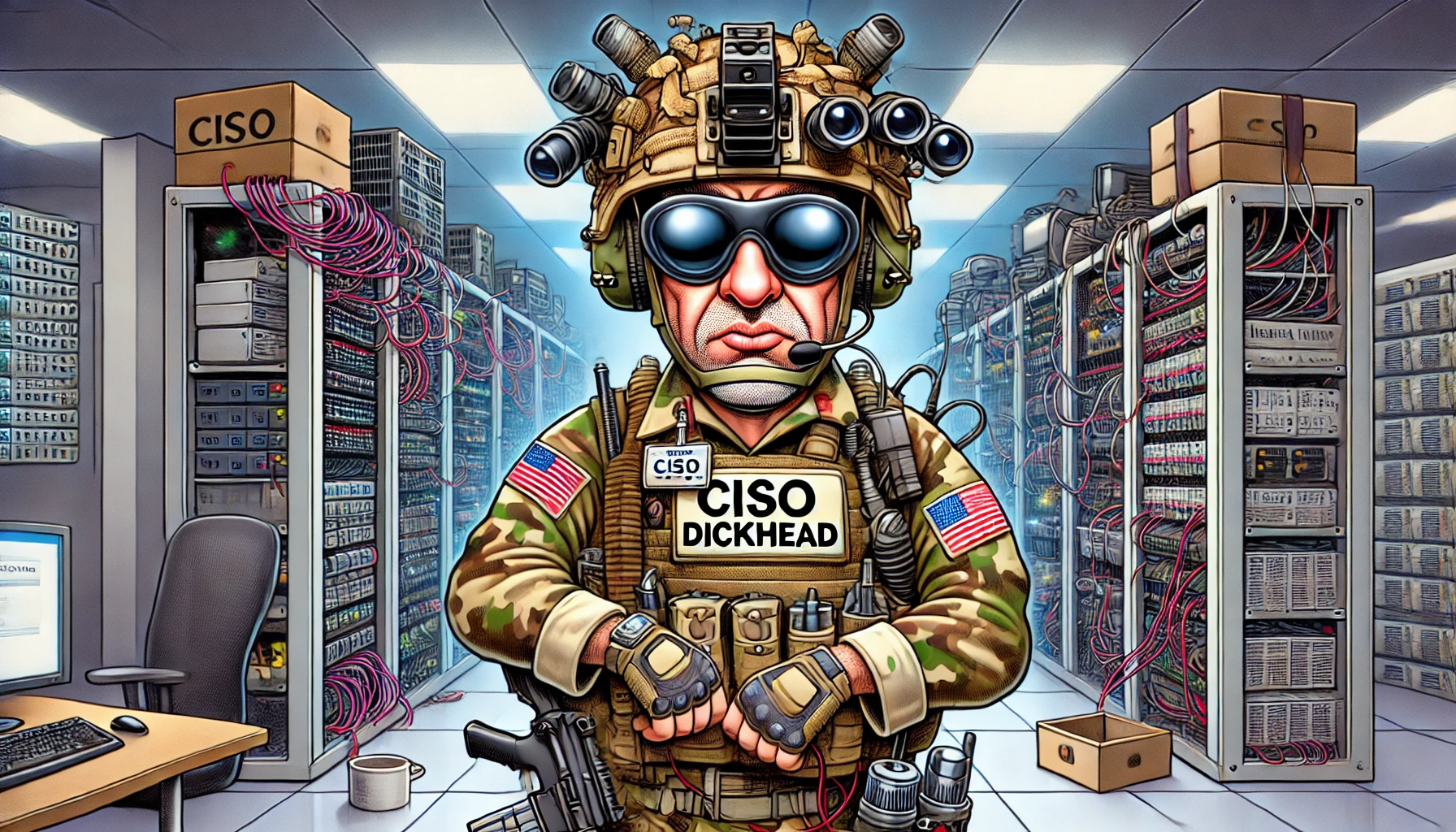1. Definition:
Meet the CISO Dickhead – a Chief Information Security Officer who behaves like a military commando patrolling the digital front lines. He has all the bravado of a Navy SEAL gearing up for a covert operation, despite the minor detail that he’s probably never configured a router correctly in real life.
This security-obsessed corporate crusader truly believes he is the last line of defense against a looming cyber apocalypse. He wields fancy hacker terminology like a weapon, dropping buzzwords like “zero-day exploit,” “advanced persistent threat,” and “cyber kill chain” in every other sentence. With every conversation sounding like he’s briefing the Pentagon, he insists on elevating even the tiniest IT hiccup into an international espionage incident. In the world of the CISO Dickhead, a mere printer glitch might as well be a full-scale nation-state cyberattack.
2. Parody Scenario:
Buckle up for a day in the life of the CISO Dickhead – a ridiculously overblown journey where ordinary office events turn into epic cyber-warfare dramas.
Morning Security Standup:
At 8:00 AM sharp, the CISO Dickhead convenes a high-drama “security standup” to kick off the day. In a dimly lit conference room (because ambiance), a giant screen displays a live animated cyber-threat map with blinking lights across continents. It looks very impressive – so much so that no one dares admit it doesn’t actually mean anything.
Our CISO stands at the front in a tactical pose, speaking in grave, clipped tones as if addressing a room of generals. He rattles off updates about a suspiciously named hacker group – something like “Operation Midnight Bear” – which he claims is “on our tail.” To top it off, he declares that the global cyber threat level has been raised to DEFCON 2(complete with a fancy color-coded chart on-screen, as if tracking incoming missiles). Most of the team just sips their coffee, trying not to laugh as he concludes the briefing with a stern “Stay vigilant, people!” – punctuating it with a salute to the imaginary flag of Cyberia.
Mid-Morning Panic:
By 10:17 AM, chaos erupts. An intern innocently sends an email with the subject line “URGENT” – big mistake. The CISO’s hyper-sensitive AI threat detection system immediately flags the all-caps word as a red alert. Alarms (literally) start blaring in the security operations center, and our CISO lunges into action, barking orders: “We’re under attack! Shut everything down NOW!” Within minutes, he’s initiated a company-wide lockdown and quarantined the email server. Employees throughout the office suddenly find their screens frozen mid-spreadsheet as he frantically scours the network for the supposed intruder.
It takes thirty frantic minutes before someone finally points out that the “threat” was just the intern emailing about an urgent doughnut delivery for an office birthday. Breathing heavily in his tactical flak jacket (yes, he actually donned a flak jacket), the CISO declares it a “valuable drill” and wipes a bead of sweat from his brow. Crisis averted – this time. The intern, meanwhile, is left terrified, thinking they nearly triggered World War III by trying to be helpful with pastries.
Afternoon Fear-Mongering Training:
Come 2:00 PM, it’s time for the mandatory all-hands Cybersecurity Awareness Training (a.k.a. three hours of pure, unfiltered fear-mongering). The lights dim and maybe even a little spooky music plays as the CISO Dickhead takes the floor, clicking through a PowerPoint deck crammed with stock photos of shadowy hackers in hoodies. He dramatically warns that state-sponsored hackers are targeting the breakroom vending machine software as we speak. “No system is too small to be compromised!” he intones, spinning a wild tale about elite foreign agents using our snack machine as their beachhead into the company’s network. A few employees exchange bewildered glances – is he serious? (Yes, yes he is.)
He shows a screenshot of what he calls a secret “dark web forum” where our company’s name is supposedly being discussed – except on closer inspection, it’s clearly just a Google search result for our company name plus the words “confidential data.” Nonetheless, a few gasps are heard (whether from actual fear or suppressed laughter is unclear). For the grand finale, he switches to a slide of neon-green Matrix code (very obviously copied from some random GitHub repository) and solemnly calls it proof that hackers are “already inside our network.” By the end of the session, employees are equal parts terrified that Russian hackers will somehow hijack the office coffee machine and exasperated that they just sat through what felt like a low-budget cyber-horror movie.
Evening Security Crackdown:
As the workday winds down, our fearless CISO isn’t done yet – now comes the evening security crackdown. At 5:00 PM, he blasts out a company-wide email (marked HIGH PRIORITY) announcing new password policies effective immediately. The requirements are so convoluted they read like a riddle: passwords must be at least 25 characters long and include uppercase letters, lowercase letters, numbers, symbols, an emoji, a haiku, and at least one ancient Egyptian hieroglyph. Oh, and you have to change them every Monday at dawn. Groans echo across the office as everyone hurriedly jots down these impossible passwords on sticky notes (thus instantly creating a huge security risk that the CISO will, of course, later classify as a “serious breach of protocol”).
But that’s not all. He also unveils a brand-new multi-factor authentication system with a completely straight face. Starting tomorrow, logging in will require three separate biometric scans (fingerprint, retina, and voiceprint) and the blood of a firstborn child. Yes, you read that correctly – the man has essentially introduced a ritual sacrifice as part of your login routine. By this point, even the IT team is rolling their eyes so far back they can see their brains. With his grand directives delivered, the CISO Dickhead packs up his gadgets, shoots one last dramatic look at his fancy threat map (still blinking away in the corner), and leaves the office convinced that he has heroically safeguarded the company for yet another day.
3. Why They Exist:
So why does the CISO Dickhead exist in the first place? In one word: theatrics. He is a performer, not a true protector. The company probably barely needs this extreme level of security – we’re talking about a business that sells paper clips or runs a chain of doughnut shops, not a nuclear launch facility. But by keeping everyone on edge and convinced that cyber doom lurks around every corner, the CISO Dickhead justifies his own budget and job security. It’s basically job insurance by way of paranoia: if he makes everyone believe the organization is under constant siege from shadowy hackers, then upper management feels compelled to keep pouring money into his security empire. In short, the CISO Dickhead isn’t truly safeguarding the company so much as he’s safeguarding his own position by always sounding the alarm. After all, if the office isn’t in a perpetual state of digital crisis, how else can he continue to play the role of heroic defender?
4. How to Spot One:
Wondering if your organization has its very own CISO Dickhead? Here are a few telltale signs:
- Claims that even trivial systems (like the cafeteria menu display) are under attack by “nation-state hackers.” (Because apparently the daily lunch special is of great interest to foreign spies.)
- Every PowerPoint presentation is plastered with cliché hacker imagery — think a faceless figure in a hoodie and streams of green Matrix code. (If every slide looks straight out of a Hollywood cyber-thriller, that’s a dead giveaway.)
- Enforces multi-layer authentication protocols so absurdly complex that even authorized employees struggle to log in. (When it takes 15 minutes, six codes, and a sherpa guide just to access your email, you know something’s off.)
- Constantly name-drops the “dark web” in conversation, with the gravity of someone who imagines he has a VIP membership to an underground hacker club.
5. How to Deal With Them:
If you find yourself under the rule of a CISO Dickhead, don’t panic. Here’s a hilarious survival guide to keep you sane (and maybe even turn the tables):
- The Fake Compliance Trick: Follow their absurd rules on the surface, then do what everyone with actual work to do does – write that 32-character password on a sticky note and stick it under your keyboard. You’ll appear to be the model of compliance while still being able to log in before retirement age.
- The False Alarm Gambit: Beat them to the punch by staging a harmless fake security scare. Casually mention you spotted a “suspicious email” or an “unusual login” before they launch into their daily panic. Then sit back and enjoy the spectacle of the CISO scrambling to respond to your phantom threat – it’ll distract them nicely and might even delay the next password policy change long enough for you to finish your work in peace.
- The ‘Ask Too Many Questions’ Move: In meetings, innocently pepper them with technical questions about their latest dire warnings. For example, ask what all those blinking dots on the fancy threat map actually mean, or whether there’s any proof that “Operation Midnight Bear” even knows your company exists. With enough pointed questions, you can watch their confident Pentagon-briefing facade start to crumble under the weight of real scrutiny.



